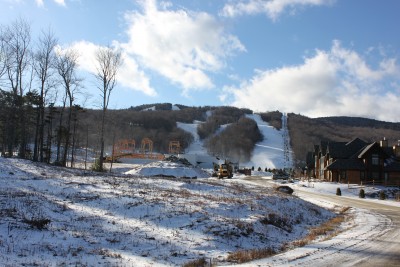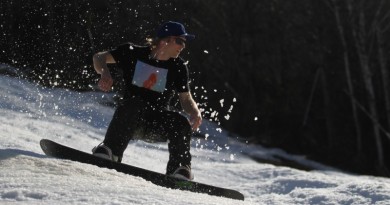Hermitage Club Brings New Life to Closed Area

Sadly, like many of the state’s abandoned ski resorts, Haystack Mountain was destined to decay. The Hermitage Club changed that.
By Evan Johnson
WEST DOVER – At the top of Hogback Mountain, if you look hard enough, you just might be able to catch a glimpse of history.
In 1946, Hogback Mountain opened as “the biggest little area in New England” with 500 feet vertical rise, four T-bars and one Pomalift. Lift tickets were $4.
Today, the trails are overgrown with young trees and the lift towers stand idle and rusting. Further southeast, near Brattleboro, it is a similar scene in the parking lot of what had been Maple Valley, with a massive A-frame lodge sitting empty in front of wide-open slopes.
There are more than 100 abandoned, canceled or defunct ski resorts in Vermont. Closed for reasons ranging from financial insolvency to lack of snow, many are relics of a bygone era and most are doomed to decay.
Miles away in West Dover, next door to Mount Snow Resort, trucks grumble uphill to the foot of Haystack Mountain hauling tons of concrete, lumber, roofing materials and equipment for installing electrical and plumbing infrastructure. In progress is a $31 million re-development of a once defunct ski area.
Slated for completion this coming February, The Hermitage Club hopes to bring new visitors – and their money – to the Deerfield Valley as Vermont’s premier private club. The 80,000-square-foot base lodge, two-lane lap pool, movie theater, gym, teen recreation headquarters, 1,500 lockers, salon and spa can all be yours for a membership fee of $65,000, starting when the club opens next year.
“What we’re providing is something that’s really not available anywhere else. It’s really that simple,” says Jim Barnes, founder and president of the club. “The people who are joining are really falling in love with skiing all over again.”
Barnes noted that interest in the club is from people who have “been skiing the Northeast and they’re used to crowded lodges, food [that’s] not great, huge lines and skied off conditions in a half hour,” particularly in states other than Vermont and closer to urban centers. The clientele of the Hermitage Club clearly want a different skiing experience.
Owner Barnes first skied Haystack while on trips through his elementary school, visiting other area resorts on weekend outings. One of the first times he visited the Hermitage Inn on Handle Road was on a snowy day with the woman who would later be his wife.
“She was a teacher and it was a snow day,” he recalls. “I called her and I said, ‘I know you’re not working today. Want to go snowmobiling in Vermont?’”
The two rode through the woods to the inn for lunch.
Barnes bought the Hermitage Inn in 2007 from then-owner Jim McGovern and proceeded to develop the area, gradually buying real estate when it became available and developing private homes. In 2011, he had the chance to purchase Haystack Mountain and the adjacent golf course. He jumped at it.
“It made sense for us because people believed in the product and service that we delivered,” he says. “It’s a four star accommodation and when we decided to do this club and do it right, people believed in us.”
At the presentation of the Club’s master plan in August, Barnes said he hopes to take in 1,500 more members over the next four years, with 200 to 300 new members every year. The Hermitage Club had 30 members the first year and 200 the next. Barnes says 400 members are signed up for this season.
The club has also bought 55 town-owned lots on the East Tract and High Peaks areas. This real estate is expected to give access to the nearby Deerfield Valley Airport, where weekly service flights from Teterboro, N.J. and Westchester, N.Y. will begin in December.
AN UNPRECEDENTED CONCEPT
Originally opened in the 1960s as an alternative to crowded ski areas, Haystack marketed itself as the upscale sister resort to Mount Snow, located along the same ridge. In 1991, S-K-I Ltd., then-owner of Mount Snow, bought Haystack. The two were never connected other than a Nordic ski trail across the ridge and S-K-I Ltd. would later merge with LBO Enterprises, to form the American Ski Company in 1996.
As the American Ski Company lost its grip on the region’s ski industry in the late 1990s and into the new millennium operations at Haystack were scaled back. Starting in 2001, the mountain was only open for weekend and holiday periods. In 2007, in a wave of sell-offs, the American Skiing Company sold both Mount Snow and Haystack; Mount Snow, along with New Hampshire resort Attitash, were sold for $73.5 million to Peak Resorts International while Haystack went for $5 million to a group of investors organized as Tyringham Ridge Inc. on the condition that it be developed into a private resort.
Initial membership sales were slow, but the stock market crash in 2008 brought them to a screeching halt. The mountain sat untouched for two winters until 2011, when Jim Barnes acquired the Haystack Club for $6.5 million.
Jeremy Davis, curator of the New England Lost Ski Area Project which is dedicated to compiling the history of ski areas since the twentieth century, says the idea of creating a private club can be a good one, particularly if the area has been historically unable to compete with nearby areas that draw larger numbers.
“There are these areas that are caught in the middle that are too big to close and too small to be open. Haystack was kind of in the middle of that. It was right next to a huge resort and never really ran on its own. Sometimes having a private owner come in and refurbish it and make it private for the owners or guests is the only way the place would ever be open again.”
With Mount Snow just up the road and Stratton a little further beyond that, a private resort at the smaller Haystack could prove worthwhile. But he says the development of small, closed areas being reopened for private ownership, is a rare phenomenon. In most situations the land on which the defunct resort sits has been divided up between various owners or designated as conservation land.
Davis says he wishes all resorts could stay open to the public, but says he’s also realistic. “It’s better to have an area operating than have it closed up and abandoned,” he says, noting that the opportunity to redevelop is a risk that few are willing to take.
BIG VENTURES

Barnes, however, is no stranger to risk and big ventures.
In 1995, he started his first company, Oakleaf Waste Management, with just $40,000 in capital. Since that beginning, the company took on national customers like Wal-Mart, Target, General Electric and United Technologies with sales approaching $700 million annually.
In 2004, he purchased from the ENRON bankruptcy the facilities management company rebranded as FM Facility Maintenance and expanded it to become the largest integrated facilities maintenance contractor in the country, offering over 45 trades of service ranging from plumbing and electrical to air conditioning, signage and pest control to every corporate-owned McDonalds, Burger King, 7-Eleven, Exxon Mobil and Outback Steak House in North America. Barnes sold the company in 2011 to its largest competitor, Waste Management.
With that money in hand, a love affair with the area and new-found time, Barnes embarked on the project.
OTHER SKI AREA COMEBACKS?
Jeremy Davis at NELSAP says he finds the Haystack concept similar to that of the intended club at what had been Round Top Ski area, which opened in 1965, just south of Killington. It closed after five years and was bought and subsequently renamed Bear Creek in 1997.
The area suffered the same effects of the real estate market slump in 2009, and closed before construction of a snowmaking development could commence. A group of developers who intended to build it into a private resort titled “Plymouth Notch” bought it in 2010, but the area suffered significant damage in 2011 from Tropical Storm Irene and the area has been closed since.
At another formerly defunct ski area, this one in Winhall, Vt., a public meeting was held in August to discuss the potential reopening of Snow Valley — a local ski hill that operated from 1938 until 1982 — as a gated community. Current plans call for the refurbishment of the ski area, including reclaiming five trails following the original trail design, a multi-purpose building at the summit, and a ski patrol building at the bottom. A helipad (reportedly for ski patrol) is also planned. No snowmaking or night skiing is planned, and the 1977 Borvig double chairlift is to be refurbished, rather than replaced.
In November, Ascutney Mountain Resort, which had been closed since 2010 due to bankruptcy, was sold at auction for $1.5 million. The sale is still pending litigation and will be finalized by the end of the month. No word publicly as to what the buyers intend do with the property.
Meanwhile, other areas have taken a different route to keeping skiers on the trails: Some areas, like Cochran’s and Northeast Slopes have moved in the nonprofit direction. Mount Eustis in Littleton, N. H. had been one of the hundreds of lost ski resorts until October 1, 2013, when it reopened as a nonprofit ski area.
The space for development – both the nonprofit and for-profit models – is certainly available, but Barnes says he remains unconvinced as to whether more private clubs like the Hermitage are likely to be on the way.
The Hermitage Club alone has required massive amounts of capital to get it to where it currently stands, he notes, and that’s a rare luxury. The money Barnes has invested – as well as that of the area’s previous owner – has put a massive operation into place and as his fulltime job, he works seven days a week, making sure his latest investment goes according to plan. To create that same amount of momentum at another time at another place would be a massive task.
The decision to develop, he says, has to be a prudent one, one that can’t be taken lightly.
“It’s not easy convincing people that you’re going to do all these things until you actually do them,” he says. “Fortunately for me, my track record has proven I follow through what I project. Until you actually do it again, no one really believes you.”

